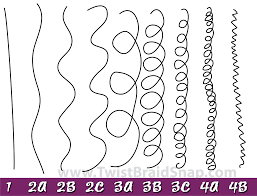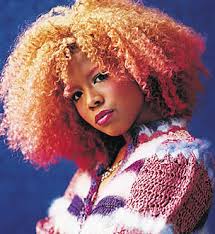This article was also featured on Black Girl with Long Hair :)
It doesn't matter what stage of natural you're in, there's always a bandwagon for you to jump on. Cone free. Baggy method. Finger detangling. Hair typing. Paraben free. DIY. Ombre. You name it, and there is a legion of natural followers swearing by it.
Not that there's anything wrong with bandwagons (theoretically), it's just that some practices/bandwagons aren't meant for ladies that are transitioning -- and the truth is, they can do more harm than good. Here are four bandwagons transitioners should steer clear of:
1. Pineappling
 Pineappling. I'm sure if you have a pulse, you've heard of this nighttime technique popularized by the likes of Curly Nikki (I believe she coined the term), Francheska of Hey Fran Hey, Jess of Mahogany Curls, and more. Pineappling involves gathering all of your hair at the front of your head with a satin (or other non-damaging) scrunchie, in an effort to protect and not disrupt curl patterns while sleeping. For those that are completely natural, this may be a perfectly viable nighttime option. However, for those transitioning, not so much. Although it does not pull/stretch the hair per-se, those with relaxer or heat damaged hair will find that the pineapple simply reverts whatever twist/braid/bantu/strawset curl or crinkle back to straight and limp. Transitioners are better off letting the pineapple go until they are completely natural.
Pineappling. I'm sure if you have a pulse, you've heard of this nighttime technique popularized by the likes of Curly Nikki (I believe she coined the term), Francheska of Hey Fran Hey, Jess of Mahogany Curls, and more. Pineappling involves gathering all of your hair at the front of your head with a satin (or other non-damaging) scrunchie, in an effort to protect and not disrupt curl patterns while sleeping. For those that are completely natural, this may be a perfectly viable nighttime option. However, for those transitioning, not so much. Although it does not pull/stretch the hair per-se, those with relaxer or heat damaged hair will find that the pineapple simply reverts whatever twist/braid/bantu/strawset curl or crinkle back to straight and limp. Transitioners are better off letting the pineapple go until they are completely natural.
2. Hair Typing
 Of all the hair bandwagons to be on, this is one of the most damaging (second only to the perfect curl witch hunt). Many folks find hair typing to be divisive, and to a certain extent correlated to ethnic background/skin tone. While there may be some truth in this, my purpose in mentioning hair typing has nothing to do with problems of this nature...maybe we'll get into that later on The Mane Objective. The reason hair typing is damaging for transitioners is because well, you don't fully have a hair type...yet. It's difficult to project how kinks, coils, and curls will behave once the heat or relaxer damaged hair is gone. Rather than relying on a typing system to tell you how to care for your new hair, pay attention to your new hair's density, thickness, porosity, and overall needs. What works, works. And what doesn't, doesn't... regardless of hair type.
Of all the hair bandwagons to be on, this is one of the most damaging (second only to the perfect curl witch hunt). Many folks find hair typing to be divisive, and to a certain extent correlated to ethnic background/skin tone. While there may be some truth in this, my purpose in mentioning hair typing has nothing to do with problems of this nature...maybe we'll get into that later on The Mane Objective. The reason hair typing is damaging for transitioners is because well, you don't fully have a hair type...yet. It's difficult to project how kinks, coils, and curls will behave once the heat or relaxer damaged hair is gone. Rather than relying on a typing system to tell you how to care for your new hair, pay attention to your new hair's density, thickness, porosity, and overall needs. What works, works. And what doesn't, doesn't... regardless of hair type.
3. Permanent Color
 This one hurts me the most. Back in the day, I had fun with color -- at the expense of my hair. As a transitioner, I find that permanent hair dye is counterproductive to the healthy hair journey. For highlights and all-over, not only does permanent color (general rule of thumb: the lighter/harsher the color, the more drastic the impact) make hair more prone to dryness, it also has the potential to loosen/disrupt your curl pattern. Dry hair is a challenge for transitioners and non-transitioners alike; why exacerbate the problem and increase the likelihood of breakage? Even ombre hair color presents a challenge for transitioners. Transitioning hair is more prone to breakage, end splitting, and is trimmed more frequently than most natural hair. I mean, the objective is to eventually get rid of the damaged ends, right? So why would you dye the ends of your hair, if you're just going to cut them anyway? (This gem comes courtesy of my boyfriend, who actually talked me out of ombre hair color for this very reason). You're better off experimenting with henna if you want a little color. There have been some reports that henna can also loosen curl patterns, I just personally have not experienced that.
This one hurts me the most. Back in the day, I had fun with color -- at the expense of my hair. As a transitioner, I find that permanent hair dye is counterproductive to the healthy hair journey. For highlights and all-over, not only does permanent color (general rule of thumb: the lighter/harsher the color, the more drastic the impact) make hair more prone to dryness, it also has the potential to loosen/disrupt your curl pattern. Dry hair is a challenge for transitioners and non-transitioners alike; why exacerbate the problem and increase the likelihood of breakage? Even ombre hair color presents a challenge for transitioners. Transitioning hair is more prone to breakage, end splitting, and is trimmed more frequently than most natural hair. I mean, the objective is to eventually get rid of the damaged ends, right? So why would you dye the ends of your hair, if you're just going to cut them anyway? (This gem comes courtesy of my boyfriend, who actually talked me out of ombre hair color for this very reason). You're better off experimenting with henna if you want a little color. There have been some reports that henna can also loosen curl patterns, I just personally have not experienced that.
4. "The Perfect Curl" Witch Hunt
 This is by far the most damaging bandwagon for anyone to be on. For some reason, many transitioners think that once they go natural, these perfectly behaved ringlets will emerge from their hair, and all they'll need to do is fluff and go. Ha, if it were that easy, many of us probably wouldn't be trimming off relaxer and heat damaged hair in the first place. Seeing your natural hair not behave in the aforementioned fashion can lead to one of three things:
This is by far the most damaging bandwagon for anyone to be on. For some reason, many transitioners think that once they go natural, these perfectly behaved ringlets will emerge from their hair, and all they'll need to do is fluff and go. Ha, if it were that easy, many of us probably wouldn't be trimming off relaxer and heat damaged hair in the first place. Seeing your natural hair not behave in the aforementioned fashion can lead to one of three things:
What are some other bandwagons that transitioners and naturals alike should steer clear of?
It doesn't matter what stage of natural you're in, there's always a bandwagon for you to jump on. Cone free. Baggy method. Finger detangling. Hair typing. Paraben free. DIY. Ombre. You name it, and there is a legion of natural followers swearing by it.
Not that there's anything wrong with bandwagons (theoretically), it's just that some practices/bandwagons aren't meant for ladies that are transitioning -- and the truth is, they can do more harm than good. Here are four bandwagons transitioners should steer clear of:
1. Pineappling
2. Hair Typing
3. Permanent Color
4. "The Perfect Curl" Witch Hunt
- You become obsessed with finding the perfect curling products, and launch full steam ahead into product junkie-ism, half used bottles of miracle products that failed, and more.
- You become disappointed in your hair's natural texture, and start contemplating going back to high heat and Just For Me.
- You accept your hair as-is, and move on.
What are some other bandwagons that transitioners and naturals alike should steer clear of?







1 Comments
Flute Ringtones download free at bestringtone.net for your phone. You can listen online best ringtone download for Android, iPhone.
ReplyDelete